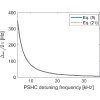D 模式罗宾逊不稳定性的解析公式
IF 16.4
1区 化学
Q1 CHEMISTRY, MULTIDISCIPLINARY
引用次数: 0
摘要
无源超导谐波腔(PSHC)方案具有相对较小的R/Q值和相对较大的品质因数(Q),可以有效降低光束负载效应,抑制模一不稳定性,因此被现有和未来的多个同步辐射光源存储环所采用。通过使用最小搜索算法求解均匀填充刚性束的模零罗宾逊不稳定性方程,我们发现大负载 Q 的 PSHC 基模可能会引发 D 模罗宾逊不稳定性 [T. He , Mode-zero Robinson instability equation of uniformly filled rigid bunches]。He , Mode-zero Robinson instability in the presence of passive superconducting harmonic cavities, ]。这种不稳定性是一种模零耦合束不稳定性,振荡频率接近 PSHC 失谐(D 模)。独特的是,它受到辐射阻尼效应的反阻尼。在本文中,我们通过几个适当的近似值,推导出了 D 模式罗宾逊不稳定性的频率和增长率的解析公式。这些公式为分析和理解 D 模罗宾逊不稳定性提供了重要启示。 美国物理学会出版 2024本文章由计算机程序翻译,如有差异,请以英文原文为准。

Analytic formulas for the
D
The passive superconducting harmonic cavity (PSHC) scheme is adopted by several existing and future synchrotron light source storage rings, as it has a relatively smaller R/Q and a relatively larger quality factor (Q), which can effectively reduce the beam-loading effect and suppress the mode-one instability. By using a minimum search algorithm to solve the mode-zero Robinson instability equation of uniformly filled rigid bunches, we have revealed that the fundamental mode of PSHC with a large loaded Q possibly triggers the D-mode Robinson instability [T. He , Mode-zero Robinson instability in the presence of passive superconducting harmonic cavities, ]. This instability is a mode-zero coupled bunch instability, with an oscillation frequency close to the PSHC detuning (D-mode). Uniquely, it is anti-damped by the radiation damping effect. In this paper, we derive analytical formulas for the frequency and growth rate of the D-mode Robinson instability by taking several appropriate approximations. These formulas provide crucial insights for analyzing and understanding the D-mode Robinson instability.
Published by the American Physical Society
2024
求助全文
通过发布文献求助,成功后即可免费获取论文全文。
去求助
来源期刊

Accounts of Chemical Research
化学-化学综合
CiteScore
31.40
自引率
1.10%
发文量
312
审稿时长
2 months
期刊介绍:
Accounts of Chemical Research presents short, concise and critical articles offering easy-to-read overviews of basic research and applications in all areas of chemistry and biochemistry. These short reviews focus on research from the author’s own laboratory and are designed to teach the reader about a research project. In addition, Accounts of Chemical Research publishes commentaries that give an informed opinion on a current research problem. Special Issues online are devoted to a single topic of unusual activity and significance.
Accounts of Chemical Research replaces the traditional article abstract with an article "Conspectus." These entries synopsize the research affording the reader a closer look at the content and significance of an article. Through this provision of a more detailed description of the article contents, the Conspectus enhances the article's discoverability by search engines and the exposure for the research.
 求助内容:
求助内容: 应助结果提醒方式:
应助结果提醒方式:


